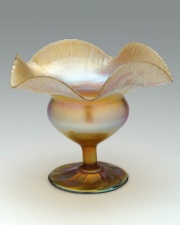Difference between revisions of "Tiffany glass"
Jump to navigation
Jump to search
m (Text replace - "\[http:\/\/cameo\.mfa\.org\/materials\/fullrecord\.asp\?name=([^\s]+)\s(.*)\]" to "$2") |
|||
| Line 1: | Line 1: | ||
| − | [[File:1995.69-SC59074.jpg|thumb|]] | + | [[File:1995.69-SC59074.jpg|thumb|Tiffany footed bowl<br>MFA# 1995.69]] |
== Description == | == Description == | ||
| Line 8: | Line 8: | ||
vidro Tiffany (Port.); Favrile glass | vidro Tiffany (Port.); Favrile glass | ||
| − | == | + | ==Resources and Citations== |
* ''Dictionary of Building Preservation'', Ward Bucher, ed., John Wiley & Sons, Inc., New York City, 1996 | * ''Dictionary of Building Preservation'', Ward Bucher, ed., John Wiley & Sons, Inc., New York City, 1996 | ||
Revision as of 09:02, 26 August 2020
Description
A common name used in the early 1900s for any stained, opalescent, or iridescent glass. Tiffany glass received its name after Louis Tiffany began using art glass, Favrile glass, in leaded lamp shades and vases.
Synonyms and Related Terms
vidro Tiffany (Port.); Favrile glass
Resources and Citations
- Dictionary of Building Preservation, Ward Bucher, ed., John Wiley & Sons, Inc., New York City, 1996
- The American Heritage Dictionary or Encarta, via Microsoft Bookshelf 98, Microsoft Corp., 1998
- Random House, Webster's Encyclopedic Unabridged Dictionary of the English Language, Grammercy Book, New York, 1997
